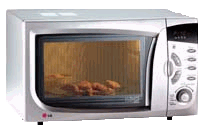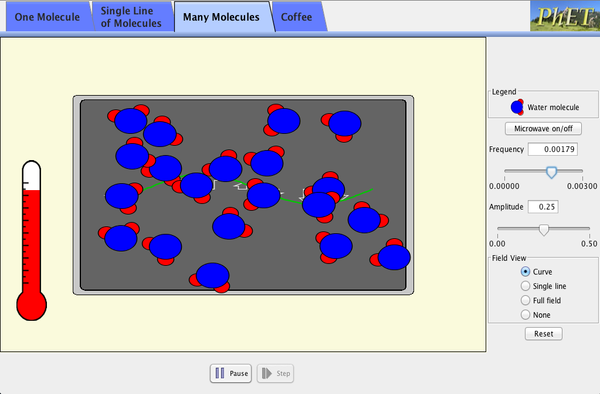    |
||||
 The Microwave Oven
The Microwave Oven |
||||
|
The microwave oven is known as a fast, quick and efficient way of cooking food. Its invention has changed the way we cook in the home. The microwaves are produced by a magnetron - a high-powered vacuum tube that generates coherent microwaves. When you have the oven on a low setting you can hear the magnetron being switched on and off - delivering bursts of microwaves instead of a full stream of them. The fan, that you can hear when the oven is on, is there to cool the magnetron - without it running the oven would overheat.
Most food stuffs contain water. Microwaves are most readily absorbed by water molecules (although fats and sugars also absorb too!). These molecules then vibrate more quickly and therefore rise in temperature. Some science books say that the frequency of microwaves used in a microwave oven is the 'natural frequecy' of water and resonance is the mechanism that causes the vibration. That is not the case - it is down to the pull of the electric and magnetic forces from the wave. Water molecules (and sugars) are polar (one part is negative compared to the other). The electromagnetic waves have an electric field that 'pulls and pushes' charged particles such as the water molecule. This causes the water molecules (that are attached together by hydrogen bonds into chains) to twist and turn. Their vibrational and rotational energy increases - so their temperature rises.So, instead of trying to interact through a natural resonance in water, a microwave oven just exposes the water molecules to the intense electromagnetic fields in strong, non-resonant microwaves. The frequency used in microwave ovens (2.45 GHz) is a sensible but not unique choice. Waves of that frequency penetrate well into foods of reasonable size so that the heating is relatively uniform throughout the foods. Leakage from these ovens makes the radio spectrum near 2.45 GHz unusable for communications - the frequency was chosen in part because it would not interfere with existing communication systems.Using a frequency that water molecules responded to strongly (as in a resonance) would be a serious mistake--the microwaves would all be absorbed by water molecules at the surface of the food and none would be able to reach molecules deeper in the food. Conduction is a slow process, so the food would not cook very well in the centre. The 2.45 GHz frequency was chosen because it is absorbed weakly enough in liquid water that the waves maintain good strength even deep inside a typical piece of food. Higher frequencies would penetrate less well and cook less evenly. Lower frequencies would penetrate better, but would be absorbed so weakly that they wouldn't cook well. Also leakage from these ovens makes the radio spectrum near 2.45 GHz unusable for communications - if lots of different frequencies were chosen it would cause a problem in communications.. The 'myth' that microwave ovens cook food inside out comes
from the fact that the inside of a food dish is where the moisture is
most probable to be found (e.g. the gravy or sauce). This is what gets
hot first. The food that
does not contain water gains heat by conduction. It
is cooler than the water therefore heat flows into it - this takes time.
That is why there is always a 'standing time' specified in the instructions
for heating food in a microwave oven. Ignoring the standing time can be
dangerous, Uneven cooking in a microwave oven can lead to bacterial safety
problems--if parts of the food aren't heated sufficiently to kill dangerous
bacteria, then you could be exposing yourself to those bacteria. Also
the lack of surface heating leaves the food relatively tasteless, as compared
to more conventional cooking - so perhaps it is best used to reheat cooked
food rather than cook from raw.. Nonmetal containers are used in microwave ovens because microwaves pass through them (unlike metal which absorbs the waves' energy and could cause sparking - see below), thereby cooking the food from all angles (top, bottom and sides) at once. The fact that the waves pass through glass and ceramics means that the containers stay relatively cool while the food they contain becomes quite hot. However, this depends on whether there is enough time for the heat energy from the water content of the food to be conducted through to the container. During long cooking periods, the food can make the container very hot! Metal in a microwave oven during the cooking cycle are a particular danger if (a) it is very thin or (b) it has sharp edges or points. Metallic illustrations on plates can be a problem (gold rims etc.) The microwaves make the electric charges vibrate in metal, so if the resistance is high (thin wires are of higher resistance than wider ones), it will get very hot and may start a fire. Charge density at sharp edges or points is greatest, charges may accumulate and then discharge as a spark. Because microwaves only penetrate about 2 cm into food before all being absorbed, the centre of most foods is cooked by heat conduction. This means that thin pieces of food cook faster than those that are cut thickly. Microwave ovens use relatively little energy and do not heat up the kitchen. Microwave ovens range in power from about 500 W to about 900 W. Knowing the wattage of your oven is vital to following microwave-oven recipes, most of which are written for 700 W models. Some microwave ovens have turntables for even microwave distribution. Others have revolving antennae for the same purpose. Always distinguish between the microwave oven and the microwave energy wave in your answer to a question. Factors that affect how fast food cooks in a microwave oven include:
|
||||
 |
||||

 The
microwave oven cooks food by using high frequency electromagnetic waves
(part of the electromagnetic spectrum - so their speed is 3 x 108
m/s in a vacuum) called microwaves at 2.45 GHz. The wavelength of mircowaves
are between 1 millimetre and 30 centimetres. Try calculating the wavelength
of microwave oven microwaves! You should KNOW the wave equation - click
The
microwave oven cooks food by using high frequency electromagnetic waves
(part of the electromagnetic spectrum - so their speed is 3 x 108
m/s in a vacuum) called microwaves at 2.45 GHz. The wavelength of mircowaves
are between 1 millimetre and 30 centimetres. Try calculating the wavelength
of microwave oven microwaves! You should KNOW the wave equation - click


